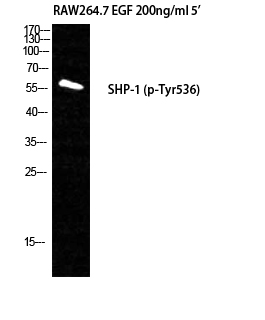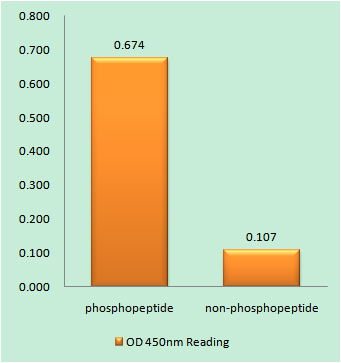
Catalog: YM8819
Size
Price
Status
Qty.
200μL
$600.00
3 weeks
0
100μL
$340.00
3 weeks
0
40μL
$190.00
3 weeks
0
Add to cart


Collected


Collect
Main Information
Target
SH-PTP1
Host Species
Rabbit
Reactivity
Human, Mouse, Rat
Applications
WB, IHC, IF, IP, ELISA
MW
68kD (Calculated)
68kD (Observed)
Conjugate/Modification
Unmodified
Detailed Information
Recommended Dilution Ratio
IHC 1:500-1:1000; WB 1:2000-1:10000; IF 1:200-1:1000; ELISA 1:5000-1:20000; IP 1:50-1:200;
Formulation
PBS, 50% glycerol, 0.05% Proclin 300, 0.05%BSA
Specificity
Endogenous
Purification
Protein A
Storage
-15°C to -25°C/1 year(Do not lower than -25°C)
MW(Calculated)
68kD
MW(Observed)
68kD
Modification
Unmodified
Clonality
Monoclonal
Clone Number
PT1030R
Isotype
IgG, Kappa
Related Products
Antigen&Target Information
Specificity:
Endogenous
show all
Gene Name:
PTPN6
show all
Protein Name:
Tyrosine-protein phosphatase non-receptor type 6
show all
Other Name:
PTPN6 ;
HCP ;
PTP1C ;
Tyrosine-protein phosphatase non-receptor type 6 ;
Hematopoietic cell protein-tyrosine phosphatase ;
Protein-tyrosine phosphatase 1C ;
PTP-1C ;
Protein-tyrosine phosphatase SHP-1 ;
SH-PTP1
HCP ;
PTP1C ;
Tyrosine-protein phosphatase non-receptor type 6 ;
Hematopoietic cell protein-tyrosine phosphatase ;
Protein-tyrosine phosphatase 1C ;
PTP-1C ;
Protein-tyrosine phosphatase SHP-1 ;
SH-PTP1
show all
Database Link:
Background:
The protein encoded by this gene is a member of the protein tyrosine phosphatase (PTP) family. PTPs are known to be signaling molecules that regulate a variety of cellular processes including cell growth, differentiation, mitotic cycle, and oncogenic transformation. N-terminal part of this PTP contains two tandem Src homolog (SH2) domains, which act as protein phospho-tyrosine binding domains, and mediate the interaction of this PTP with its substrates. This PTP is expressed primarily in hematopoietic cells, and functions as an important regulator of multiple signaling pathways in hematopoietic cells. This PTP has been shown to interact with, and dephosphorylate a wide spectrum of phospho-proteins involved in hematopoietic cell signaling. Multiple alternatively spliced variants of this gene, which encode distinct isoforms, have been reported. [provided by RefSeq, Jul
show all
Function:
Catalytic activity:Protein tyrosine phosphate + H(2)O = protein tyrosine + phosphate.,Function:Plays a key role in hematopoiesis. This PTPase activity may directly link growth factor receptors and other signaling proteins through protein-tyrosine phosphorylation. The SH2 regions may interact with other cellular components to modulate its own phosphatase activity against interacting substrates. Together with MTUS1, induces UBE2V2 expression upon angiotensin II stimulation.,PTM:Phosphorylated on serine and tyrosine residues.,similarity:Belongs to the protein-tyrosine phosphatase family. Non-receptor class 2 subfamily.,similarity:Contains 1 tyrosine-protein phosphatase domain.,similarity:Contains 2 SH2 domains.,subcellular location:In neurons, translocates into the nucleus after treatment with angiotensin II.,subunit:Monomer. Interacts with MTUS1 (By similarity). Binds PTPNS1, LILRB1 and LILRB2. Interacts with FCRL2, FCRL3, FCRL4, CD300LF and CD84.,tissue specificity:Isoform 1 is expressed in hematopoietic cells while isoform 2 is expressed in non-hematopoietic cells.,
show all
Cellular Localization:
Cytoplasm. Nucleus. In neurons, translocates into the nucleus after treatment with angiotensin II (By similarity). Shuttles between the cytoplasm and nucleus via its association with PDPK1. .
show all
Tissue Expression:
Isoform 1 is expressed in hematopoietic cells. Isoform 2 is expressed in non-hematopoietic cells.
show all
Research Areas:
>>Adherens junction ;
>>JAK-STAT signaling pathway ;
>>Natural killer cell mediated cytotoxicity ;
>>T cell receptor signaling pathway ;
>>B cell receptor signaling pathway ;
>>Pathogenic Escherichia coli infection ;
>>Leishmaniasis ;
>>Proteoglycans in cancer ;
>>PD-L1 expression and PD-1 checkpoint pathway in cancer
>>JAK-STAT signaling pathway ;
>>Natural killer cell mediated cytotoxicity ;
>>T cell receptor signaling pathway ;
>>B cell receptor signaling pathway ;
>>Pathogenic Escherichia coli infection ;
>>Leishmaniasis ;
>>Proteoglycans in cancer ;
>>PD-L1 expression and PD-1 checkpoint pathway in cancer
show all
Signaling Pathway
Cellular Processes >> Cellular community - eukaryotes >> Adherens junction
Organismal Systems >> Immune system >> Natural killer cell mediated cytotoxicity
Organismal Systems >> Immune system >> T cell receptor signaling pathway
Organismal Systems >> Immune system >> B cell receptor signaling pathway
Human Diseases >> Cancer: overview >> PD-L1 expression and PD-1 checkpoint pathway in cancer
Environmental Information Processing >> Signal transduction >> JAK-STAT signaling pathway
Reference Citation({{totalcount}})
Catalog: YM8819
Size
Price
Status
Qty.
200μL
$600.00
3 weeks
0
100μL
$340.00
3 weeks
0
40μL
$190.00
3 weeks
0
Add to cart


Collected


Collect
Recently Viewed Products
Clear allPRODUCTS
CUSTOMIZED
ABOUT US
Toggle night Mode
{{pinfoXq.title || ''}}
Catalog: {{pinfoXq.catalog || ''}}
Filter:
All
{{item.name}}
{{pinfo.title}}
-{{pinfo.catalog}}
Main Information
Target
{{pinfo.target}}
Reactivity
{{pinfo.react}}
Applications
{{pinfo.applicat}}
Conjugate/Modification
{{pinfo.coupling}}/{{pinfo.modific}}
MW (kDa)
{{pinfo.mwcalc}}
Host Species
{{pinfo.hostspec}}
Isotype
{{pinfo.isotype}}
Product {{index}}/{{pcount}}
Prev
Next
{{pvTitle}}
Scroll wheel zooms the picture
{{pvDescr}}



















